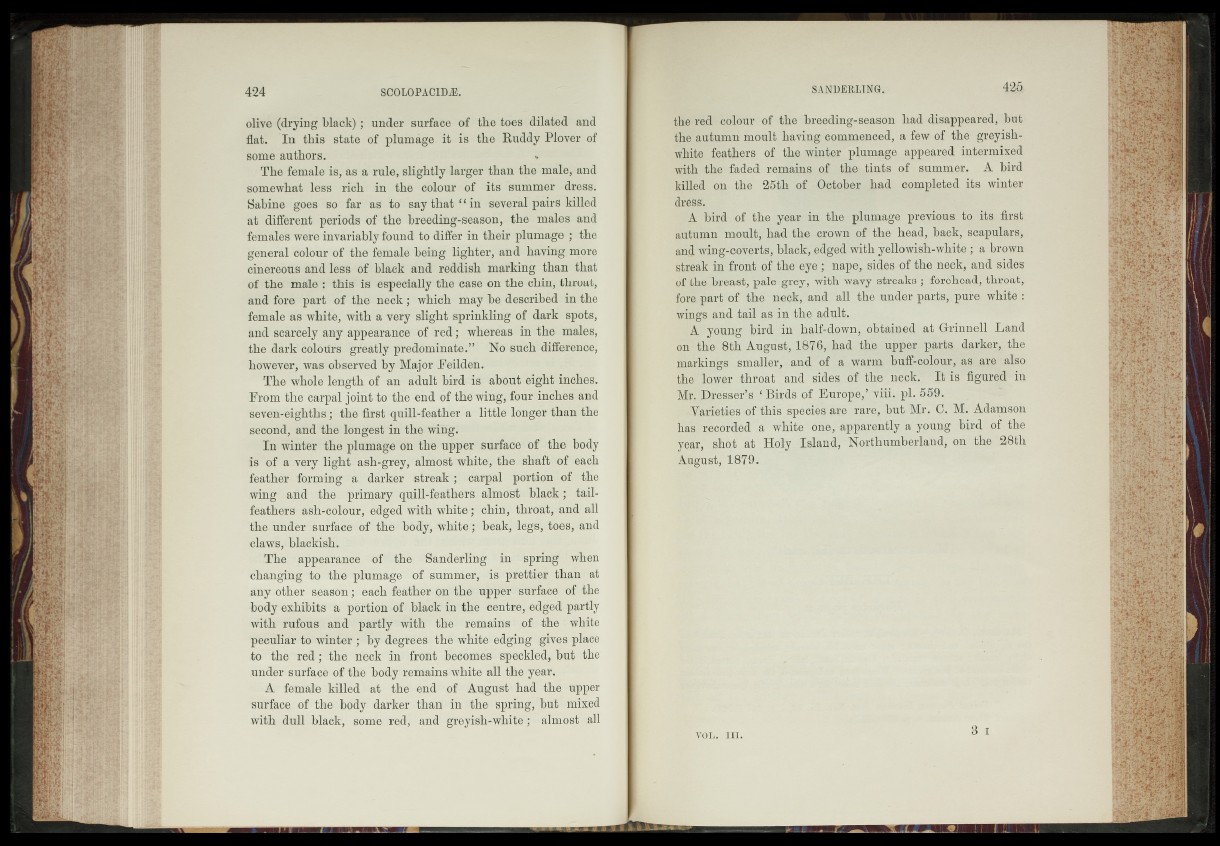
olive (drying black); under surface of the toes dilated and
flat. In this state of plumage it is the Ruddy Plover of
some authors. - ,
The female is, as a rule, slightly larger than the male, and
somewhat less rich in the colour of its summer dress.
Sabine goes so far as to say that “ in several pairs bailed
at different periods of the breeding-season, the males’;and
females were invariably found to differ in their plumage ; the
general colour of the female being lighter, and having more
cinereous and less of black and reddish marking than that
of the male : this is especially the case on the chin, throat,
and fore part of the neck; which may be described in the
female as white, with a very slight sprinkling of dark spots,
and scarcely any appearance of red; whereas in the males,
the .dark'colours greatly predominate.” Mo such difference,
however, was 'observed by Major- Feilden. >
The whole length of an adult bird is^ about eight inches.
From the carpal joint to the end of fie wing,-four inches and
seven-eighths; the first quill-feathers little longer- than the
Second, and the longest in the wing.
In winter the plumage on the upper surface of the body
is"%f a-veiiy light ash-grey, almost white, the. shaft of each
feather forming a darker Streak ■; ? carpal portion of * the
wing and the primary quil-feathers.almost black; tail-
feathers ash-colour, edged with white; chin, throat;.an.4' all
‘the under surface of the body, white; beak, legs,.toes, and
•claws, blackish. &£
".The appearance -of the Bariderling in spring.5when
changing "‘to the phnhage’. of summery **is-*prettier'than at
sny other season; each feather on the 'upper surface* of the
•body exhibits a portion e h black in 'the -centre, edged partly
with rufous and partly with*’ the remains^pf. the ' white
peculiar to* winter /'b y degrees the white^ed^ng^gives^place
to the red; the heck^in front becomes'^Speckled; but^the
under surface of the body r.emains v^Mite all the year.
A female killed at the end' of August vha'ct- the upper
surface of the body darker than in ’-the spring, hut -mixed
with duiK black, some red, and. •greyish white; ■ almO§tf*all
tbe red- SMbur of the breeding-season had disappeared, ’but*
the autumn moult having-corgmenced, a few of the greyish-
white ./feathers of the winter pfiWig.6 appeared intermixed
with the faded remains of fie tints of summer. A bird
killed on the 25fi of October bad completed, its winter
dress.
A bird' of- the year in the plumage previous-to its first
autumn moult,, had the-crown oh1 the head, hack, scapulars,
an<f wfng-coverts, black, edged”with yellowish-whifp brown
streak in front of the eye; nape, sides of the neck, and sides
o’f fiCbreast, pale-grey,' wifi wavy streaks ; forehead, throat,
foi&part of neck, and all fie under parts,, pure white :
wings and tail as in the adult.
A yöpng bird., in half-down.'.obtained.gaib'&Mnn ^ l Land
on-the Qth August,X§Jß, had fig...upper parts darker, the
markings smaller, p and of a warm buff-cpl§u,?> as are ■’also
nwRr firo a t /and" ödes pf’the nepk. It is figured in
^Mlress^rV ‘ Eird>r of Europe/'yrii, pi. 559.-
^arietiespftbis species are M. Adamson
hs^recorded a' white *e|ipr| apparently a young bird, of-fip
year/;|tpt at Holy Island, Mprthumberland, on the 28th
Aifgust, 1879/ r